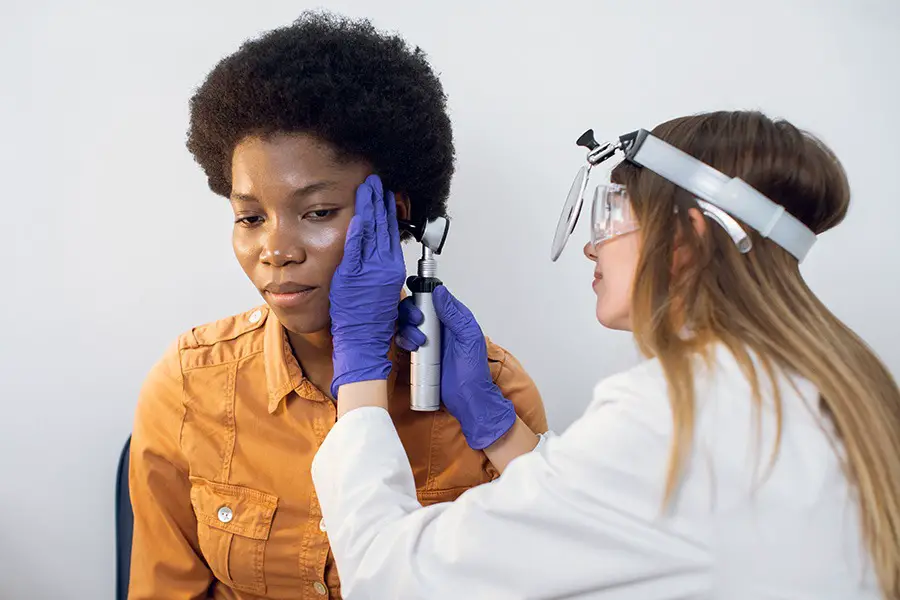Introduction
Sensorineural hearing loss (SNHL) is a prevalent issue, particularly among the older population, which significantly influences their life quality. This type of hearing loss is attributable to damage in the inner ear, more specifically, the hair cells or nerves responsible for sound transmission to the brain. While aging is a key factor contributing to SNHL, an increasing consensus points towards the vital role of environmental factors and lifestyle choices in maintaining auditory health.
The wonder of sound forms an intrinsic component of our life, threading through our memories and feelings. It enables us to communicate, appreciate music, and remain connected with our surroundings. Therefore, preserving this invaluable capability, especially as we grow older, is of paramount importance.
This in-depth guide aims to equip seniors afflicted with SNHL with insights into how awareness regarding noise pollution, regular physical activity, professional considerations, and a healthy lifestyle can assist in preventing further deterioration of hearing. By exploring these essential facets, we can spotlight proactive steps that can be employed to safeguard and enhance auditory health.
The Influence of a Healthy Lifestyle on Preventing Sensorineural Hearing Loss
Maintaining a healthy lifestyle lays a solid foundation for comprehensive well-being, encompassing auditory health. Proper nutrition, for instance, nourishes the body with vital vitamins and minerals needed for optimal functioning of the auditory system. Evidence indicates that nutrients such as omega-3 fatty acids, vitamin B12, and folic acid could provide a protective shield against SNHL.
Smoking and excessive alcohol intake are identified as risk factors for SNHL. Both of these habits can lead to blood vessel damage, which restricts the blood supply to the inner ear, potentially impacting hearing ability. Consequently, abandoning smoking and moderating alcohol consumption become key elements of a healthy lifestyle aimed at SNHL prevention.
An aspect of healthy living that often slips under the radar is adequate sleep. Inadequate rest can aggravate tinnitus – a ringing in the ears that is frequently associated with SNHL. Ensuring sufficient rest and sleep might help manage tinnitus, thereby elevating the life quality for individuals dealing with SNHL.
Noise Pollution and Sensorineural Hearing Loss – A Call for Increased Awareness
In today’s era, noise pollution, whether it’s occupational or recreational, is a growing concern. Persistent exposure to loud noises can cause irreversible damage to the inner ear’s hair cells, leading to SNHL. Therefore, heightening awareness about this preventable cause of hearing loss is paramount.
Employing protective gear such as earplugs or earmuffs in noisy environments serves as an effective preventive measure. It’s also crucial to allow regular noise-free intervals for your ears. Maintaining a tranquil home environment and ensuring the volume of televisions, radios, and personal audio devices stays within safe limits can significantly contribute to SNHL prevention.
In the current digital age, the risk of noise-induced hearing loss extends beyond loud concerts or machinery noise at workplaces. Personal audio devices, like headphones and earbuds, can produce sound levels high enough to cause harm over time. Promoting awareness about safe listening practices, such as adhering to the 60/60 rule – playing music at a maximum of 60% volume for a duration of 60 minutes a day – can help mitigate this risk.
Please find the continuation of the blog post in the next response to comply with character limits.
Audien BTE (Behind the Ear) Rechargeable OTC Hearing Aid
Experience Unparalleled Sound Quality with the New Audien BTE (Behind the Ear) hearing amplifier. Elevate your hearing with the clearest, highest-quality sound available in an over-the-counter hearing assistance device. Designed by Audien, renowned for their sleek and comfortable hearing devices, the BTE model ensures exceptional hearing performance. It features advanced digital technology, including four environmental modes, background noise reduction, feedback cancellation, and two directional microphones per unit (four in total).
Say Goodbye to Missed Conversations and Hello to Superior Sound. Audien hearing devices excel at amplifying speech while reducing background noise, allowing you to effortlessly engage in conversations with friends and family. Experience the consistent, long-lasting, and sharp sound quality without any whistling or feedback issues. With customizable volume control, you can easily adjust the amplification to meet your individual needs. These devices are perfect for enhancing high tones and improving TV dialogue clarity.
Rechargeable for Uninterrupted Use. The Audien BTE hearing amplifiers are 100% rechargeable, offering convenience and freedom from the hassle of tiny button batteries. With wireless magnetic charging technology, you can enjoy a 20-hour battery life with just a quick two-hour charging time. The included charging case provides up to three full charges, giving you a total of 60 hours of amplified sound. Simply place the devices in the case, and they will wirelessly charge, ensuring you’re always ready to hear your best. Experience the ease and reliability of Audien sound amplifiers, ideal for individuals with dexterity issues or those tired of constantly purchasing and replacing batteries.
Taking on Sensorineural Hearing Loss – An Occupational Standpoint
Certain occupations inherently carry a heightened risk of SNHL due to their association with loud environments. Careers in construction, manufacturing, mining, and military involve exposure to high noise levels that can cause hearing damage over time.
Employers shoulder a significant responsibility in protecting their employees’ auditory health. Implementing noise control measures, providing appropriate hearing protective devices, and conducting regular hearing checks comprise a comprehensive occupational hearing loss prevention program.
Moreover, educating employees about the risks of noise exposure, safe listening practices, and early indications of hearing damage is vital. Equipped with this knowledge, employees can take proactive measures to safeguard their hearing and seek prompt medical help when necessary.
Interestingly, even professions not typically linked with high noise levels, like music teaching, can pose a risk for SNHL due to the elevated sound levels often present in these environments. Recognizing the need for hearing conservation programs in such professions highlights the ubiquitous nature of the risk of noise-induced hearing loss.
Guarding Your Hearing – Advice to Prevent Sensorineural Hearing Loss
When it comes to SNHL prevention, proactive steps are invaluable. Alongside lifestyle alterations and noise control, routine hearing checks are a vital part of preventive care. Early identification of hearing loss facilitates timely intervention, which can limit further progression.
Another essential recommendation is effective stress management. Chronic stress can intensify tinnitus, a common SNHL symptom, making it more distressing. Incorporating stress management techniques, like mindfulness and yoga, into your daily routine can assist in managing tinnitus and improving overall well-being.
If you’re on medication, awareness of ototoxic drugs – medicines that can harm the inner ear leading to hearing loss – is important. While these medications are often necessary for managing certain health conditions, discussing the associated risks and potential alternatives with your healthcare provider is crucial.
The Connection Between Exercise and Sensorineural Hearing Loss
Physical activity is beneficial for almost every aspect of health, and hearing health is no exception. Regular exercise enhances blood circulation to the ears, aiding their health and function. Some studies suggest that higher physical activity levels might correlate with a reduced risk of hearing loss.
However, the benefits are not confined to aerobic exercise. Balance exercises can also be beneficial for individuals with SNHL. Since the inner ear plays a crucial role in maintaining balance, exercises that improve balance can help manage balance issues frequently associated with SNHL.
Moreover, exercise can help manage stress and improve sleep quality, both of which are beneficial for individuals with SNHL. Consulting with a healthcare provider before starting any new exercise regime is essential, especially for seniors with pre-existing health conditions.
Conclusion
Sensorineural hearing loss, a common condition among seniors, can significantly impact one’s quality of life. However, armed with knowledge and awareness, individuals can take proactive measures to prevent or slow the progression of this condition. A healthy lifestyle, inclusive of proper nutrition, avoidance of harmful habits, and adequate sleep, forms the bedrock of SNHL prevention.
Creating awareness about noise pollution and its potential risks is essential, given the pervasive nature of noise in contemporary life. Whether it’s in the workplace or at home, effective noise control measures can significantly mitigate the risk of noise-induced hearing loss.
Regular hearing checks, stress management, and awareness of ototoxic medications form other crucial elements of SNHL prevention. Additionally, engaging in regular physical exercise can yield extensive benefits for hearing health and overall well-being.
While coping with SNHL can be daunting, a wide range of preventive measures and coping strategies are available. With this knowledge, seniors with SNHL can regain control over their auditory health, laying the foundation for an improved quality of life.
Remember, preserving your hearing is not merely about keeping the music of life playing; it’s about remaining connected, engaged, and empowered.

Decoding Silence: An Analytical View on the Advances in Conductive Hearing Loss Research and Treatment
This analytical article sheds light on conductive hearing loss, offering an in-depth exploration of its genetic factors, treatment advances, and promising experimental therapies.

Embracing the Melody of Life: Navigating the Journey with Conductive Hearing Loss
A blog post delving into the experiences and challenges of living with conductive hearing loss, discussing its impact on everyday life, social interactions, mental health, and the potential benefits of hearing aids and cochlear implants.





